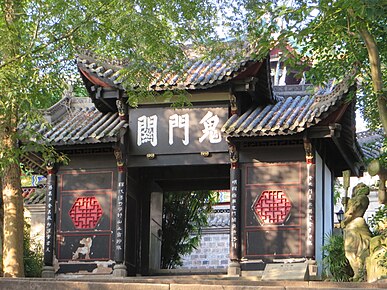Gate of the Ghosts

| Part ofa serieson |
| Chinese folk religion |
|---|
 |
TheGate of the Ghosts[2](simplified Chinese:Quỷ môn quan;traditional Chinese:Quỷ môn quan;pinyin:Guǐmén guān), or Devil's Gate,[3]Demon Gate,[4]known asGuimen guaninChinese,[5]is a pass in theUnderworldinChinese mythology.[6]
The gate is apailou[7]with the words "Gate of the Ghosts" written on the horizontal plaque.[8]Legend has it that on their way to the Ghost Country, the dead must pass through this gate.[9]
Use of the Gate[edit]
The Gate of the Ghosts plays a significant role during theGhost Festival,which is celebrated in the seventh month of the lunar calendar in Asian countries such as China.[10]According to Chinese mythology, every year onJuly 1,the King of Hell opens the Gates of the Ghosts to allow those who have suffered and been imprisoned in hell to exit there.[11]The ghosts have a shortchance to wander on earth and enjoy the living world. The gate closes at the end of July, which is therefore considered an unlucky month. Tradition says that people should neither get married or move to a new home during July.[10]
Traditionally, during this time, people would worship and conjure their deceased relatives by burning money, ingots and paper candles, putting upriver lanterns,and in other ways to pray for the blessing of the ancestors. These actions are believed to help eliminate disasters and increase blessings, or to save the dead and resolve grievances.[11]Today, the Ghost Festival has become a traditional virtue offilial pietyin Chinese culture. Inhabitants of Northern China still burn paper money during the festival to pay homage to their ancestors and express their longing for their loved ones.[10]
References[edit]
- ^"File:Gates of Hell at Fengdu Ghost City.JPG - Wikipedia".commons.wikimedia.org.Retrieved2022-02-12.
- ^Chen, F.P.L. (2017).Marionette Plays from Northern China.State University of New York Press.p. 60.ISBN978-1-4384-6483-1.
- ^Stafford, C. (2000).Separation and Reunion in Modern China.Cambridge University Press. p. 97.ISBN978-0-521-78434-4.
- ^Skinner, G.W.; Harrell, S.; Lavely, W.; Shen, Z. (2017).Rural China on the Eve of Revolution: Sichuan Fieldnotes, 1949-1950.University of Washington Press.p. 175.ISBN978-0-295-99943-2.
- ^Studio, M.S.W.; Li, Q.; Hegel, R.E. (2020).Further Adventures on the Journey to the West.University of Washington Press.p. 174.ISBN978-0-295-74773-6.
- ^Li Ni, Zheng Mingwu (2014).Twin peaks facing each other - the Devil's Gate.Jilin Publishing Group Co., Ltd. p. 3.ISBN978-7-5463-4916-9.
- ^"Exploration of Chinese Traditional Culture Communication in Foreign Online Games".People's Daily.2018-06-28.
- ^A treasure trove of traditional Chinese folk culture.Yanbian People's Publishing House.2000.ISBN978-7-80648-362-6.
- ^The World of the Chinese Gods and Spirits.Jiuzhou Publishing House. 2002.ISBN978-7-80114-707-3.
- ^abcStella Ko and Georgia McCafferty."Hungry Ghost Festival: Paying tribute to ancestors by burning paper".CNN.Retrieved2022-02-12.
- ^abTeiser, Stephen F. (1988).The Ghost Festival in Medieval China.Princeton University Press.ISBN978-0-691-02677-0.



